The Architectural Ride at Battersea Power Station by Atelier Zündel Cristea
London's Battersea Power Station is transformed into a museum of architecture and surrounded by a giant roller coaster in these competition-winning proposals by French studio Atelier Zündel Cristea (+ slideshow).
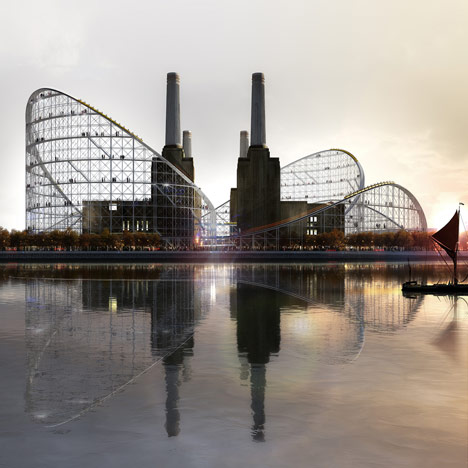
The conceptual plans were awarded first prize in the international competition coordinated by ArchTriumph, which invited applicants to suggest how the crumbling brick landmark could be used as an exhibition centre dedicated to architecture.
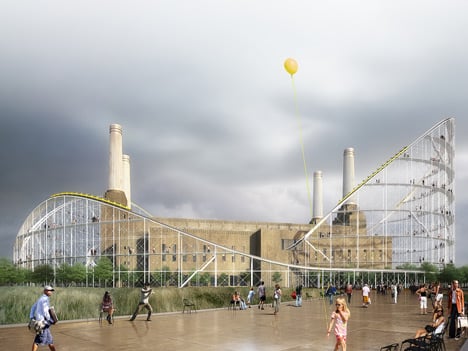
"Our aim was to imagine a new cathedral to architecture, a building that will challenge its sister structure, the Tate Modern, for international acclaim," said Atelier Zündel Cristea, explaining how they looked to Herzog & de Meuron's renovation of the Bankside Power Station for inspiration.
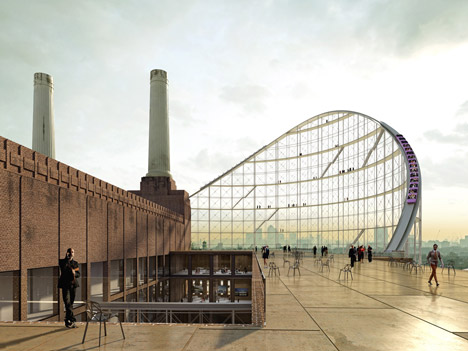
A curved scaffolding structure would weave in and around the building, creating a network of pathways between the exhibition spaces and providing the tracks for the roller coaster running along on top.
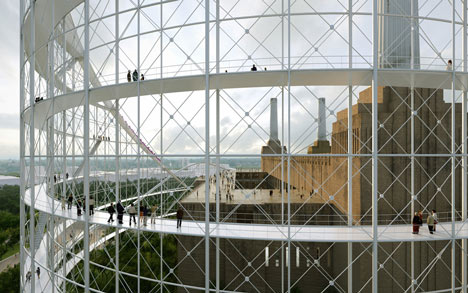
"We conceived of a double-faceted project," said the architects. "On one hand, a calm and contemplative interior, dedicated to the collection's display; on the other, an exterior opening upon the surrounding landscape and providing breathtaking views.
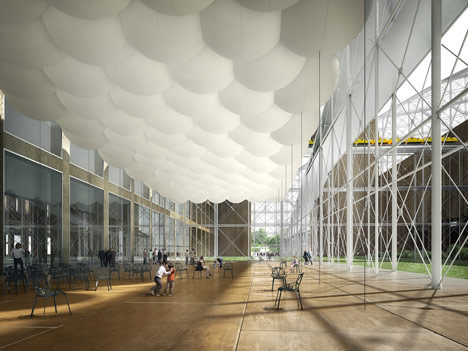
Designed by architect Sir Giles Gilbert Scott, Battersea Power Station was constructed in the 1930s and spent over 50 years generating electricity for London. Over the years since its decommissioning, the building and its surrounds have invited dozens of development proposals and the site is currently earmarked for a mixed-use complex of apartments, shops, offices and a theatre.
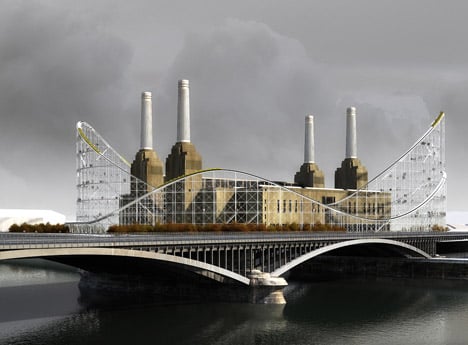
Past proposals for Battersea Power Station include Rafael Viñoly's plans for a 300-metre tower and an "Eco-Dome" and Terry Farrell's idea to convert the building into a park. There was also an offer to convert it into a football stadium. Read more about Battersea Power Station.
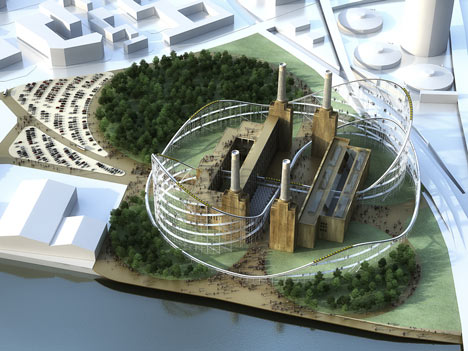
Another extreme proposal for an iconic building released recently was a plan to extend the Guggenheim Museum in New York by continuing the spiral upwards.
Here's a detailed description from Atelier Zündel Cristea:
Battersea Power Station London
The Site
London stands on the River Thames, its primary geographical feature, a navigable river which traverses the city from the southwest to the east. The city is home to numerous museums, galleries, libraries, sporting events and such cultural institutions as the British Museum, National Gallery, Tate Modern, British Library, Wimbledon, as well as over 40 major theatres.
The Battersea Power Station, which was built between 1930 and 1955, is situated a few miles south of Marble Arch on the south bank of the Thames, facing the borough of Chelsea. The decommissioned station is one of the best known landmarks in London and an excellent example of Victorian architecture. It is also the largest brick building in Europe, notable for its original Art Deco interiors and decor.
The area surrounding the site is characterised by a mix of residential, commercial, and industrial uses, with the presence of warehouses as well as rail infrastructure. Battersea Park, situated on the banks of the Thames towards the west, is an important element in the makeup of the neighbourhood. Like the power station, Battersea Park has its own fascinating history, from the Fun Fair which began as the Pleasure Gardens of the 1951 Festival of Britain, to the new century's Millennium Arena.
A Temple of Power
The Battersea Power Station was built, due to the proximity of the cooling presence of water, on a 61,000m² plot of land situated on the south banks. From its inception, the station was very popular. It symbolised progress, industry, and a new type of power: the Power of the People.
The structure is made of a steel frame with brick cladding, similar to the skyscrapers built in the United States around the same time. The building's large dimensions measure 160 metres by 170 metres, with the roof of the boiler house extending to over 50 metres high. The four chimneys are made of concrete and reach a height of 103 metres.
After being in operation for 40 years, the two wings have both ceased generating electricity, A station in 1975, B station in 1983. Over its seventy year history, the station has taken on iconic status, having been represented in many forms of popular culture, from films to music videos to video games.
A New Site for Architectural Pleasures
Our project envisions the regeneration of the Battersea site within a new park combining leisure and architecture, in creating a popular spot welcoming to all, dedicated to the pleasures of mind and body, replete with unique experiences. A space for learning, relaxation, and discussion; an architectural and cultural village in the heart of the city.
A museum of architecture, based on the Parisian Cité de l'Architecture model, will through a series of galleries present a panorama of architecture and cultural heritage from the Middle Ages to today. A highly varied collection of materials will illustrate the major changes that have taken place in international and British architecture throughout the centuries. Abbeys, cathedrals, historic city mansions display the wealth of their sculpted and painted decor, as well as the complexity of their structures. Train stations and skyscrapers attest to the technological and formal innovations of the modern era. Public and residential buildings bear witness to the changes in society and lifestyles.
The originality of the collections stems as much from the monumental scales of the displayed volumes as from the remarkable variety of supporting materials: stained glass, scale models, drawings, books, films, and prototypes… The discovery of which invites visitors on an architectural journey through time and space.
We tried to keep in mind the principal reasons for why people would visit the new Battersea Museum of Architecture: the opportunity to see and experience architecture while learning about it as a profession and discussing it with others; people watching and mingling amongst fellow visitors; exploring the architectural setting of the power station; revisiting familiar works of art and architecture. Our aim was to imagine a new Cathedral to Architecture, a building that will challenge its sister structure, the Tate Modern, for international acclaim, and establish a new visual reference point for the city.
A Playground for the Mind and for the Body
The development of culture is one of the highest possible human ideals. Therefore, in every museum it is not the exhibition of works that has meaning, but the presence of visitors and their wandering through and exposure to displays of works that stimulate meaning.
We have introduced the foreign element of a rail into the space of the power station, which will function above all in animating the empty space. It will offer visitors entering the structure a primary pathway, allowing them to take in the essential layout of the building with a minimum of effort. With the pathway determined by the presence of the rail, the simple fact of moving through the exterior and interior spaces of the station begins to make sense.
In its spatial ambition, our project encourages play and fun, categories largely devalued in the traditional world of art. Conceived in this way, cultural spaces are liable to attract new types of visitors. Our project puts the power station on centre stage, the structure itself enhancing the site through its impressive scale, its architecture, and its unique brick material. Our created pathway links together a number of spaces for discovery: the square in front of the museum, clearings, footpaths outside and above and inside, footpaths traversing courtyards and exhibition rooms.
The angles and perspectives created by the rail's pathway, through the movement within and outside of the structure, place visitors in a position where they can perceive simultaneously the container and its contents, the work and nature. They come to participate in several simultaneous experiences: enjoying the displayed works, being moved by the beauty of the structure and the city: river, park, buildings.
The project has the strength of evoking the dimension and scale of man in the contemporary era, putting into question our relationship to the structure. It is not only a matter of showing, but also of suggesting post-industrial poetry. We conceived of a double-facetted project: on one hand, a calm and contemplative interior, dedicated to the collection's display; on the other, an exterior opening upon the surrounding landscape, providing breathtaking views.
Museums are NOT FUN! Museums are FUN!
Can we design a museum in which new design ideas are explored, architectural experimentation is encouraged, and the profession challenged, while attracting large numbers of visitors? Alongside certain serious and important topics, the element of fun in museums is important!
For some people, "fun" is a loaded word. Some people would consider words like enjoyable, pleasant, worthwhile and so on, better terms of evaluation for the experience of visiting a museum. For a certain proportion of regular museum goers, "fun" is simply not a word they would consider using in describing the museum experience, implying as it might for them dumbing down, simplification, or out of place hands-on activities, commotion and even noise. Unsurprisingly, almost all of these respondents are over the age of 50. When it comes to younger respondents however, "fun" is a word often used to describe the museum experience, and in very positive terms. But the use of the word "fun" in describing the museum experience should no longer be limited to a particular generational or social category.
We believe that museums can make learning "fun", therefore museums can be "fun". As young adult architects with children, we often seek out experiences that combine fun and culture. Museums can provide artistically qualitative but fun activities for the entire family. And this is a trend we are delighted to see taking shape, the positive connotation of "fun" for many people with regard to museum going. Generally, museums are indeed fun, and we hope that increasing numbers of people come to view them as such, regardless of age.